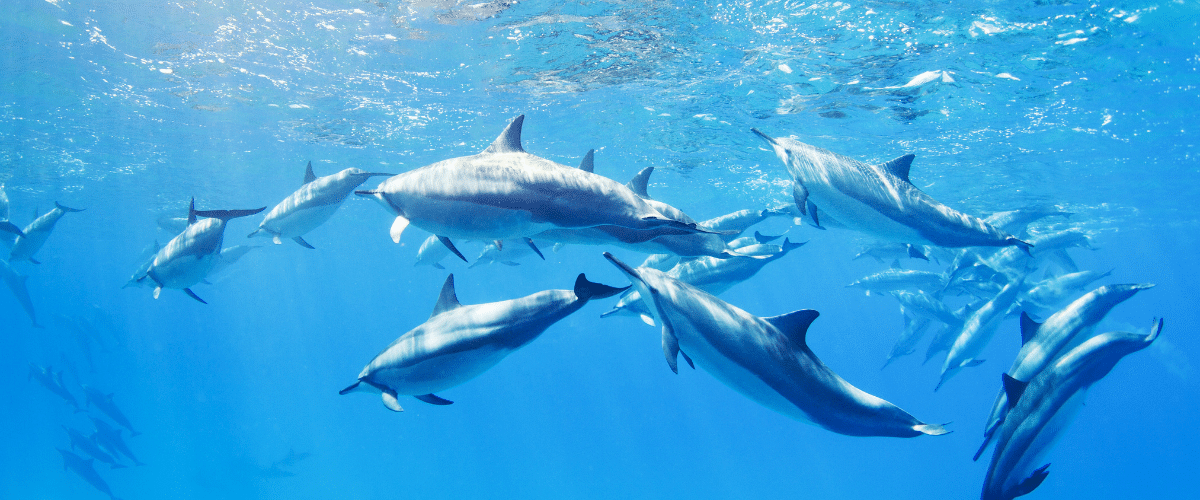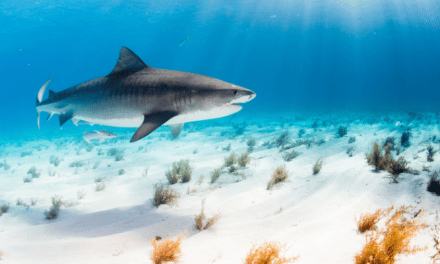By Chris Butler-Stroud and Sarah Dolman, Whale and Dolphin Conservation
For International Marine Mammal Protection Day, we asked WCD what laws they would like to see changed to protect marine mammals. This is their response.
The increasing pressures that marine mammals face worldwide, including bycatch and pollution (noise, litter, and chemical), remain an ongoing conservation and welfare challenge. In all ocean basins, anthropogenic impacts are leading to population declines and extinctions. Entire populations as well as individuals are suffering. Marine mammals are also impacted directly by the twin global crises of biodiversity and climate that are central to our changing planet.
Historically, laws relating to nature appear to evolve gradually, and they have moved from the distributive to proscriptive. A rather elastic relationship of law, policy, and science has often seen science progress before the law, and sometimes normative change has shaped law that is not immediately complemented by the scientific evidence.
Many laws have been necessary due to human mismanagement of ‘resources’ leading to overexploitation of wildlife and the natural environment. Only recently have moral and ethical issues become part of the debate, and the articulation of the precautionary principle has allowed for the beginning of appropriate checks and balances.
History reveals a plethora of national laws that seek to conserve species, but the recognition that international legal regimes are also necessary is comparatively new.
Initially, the common position seems to have been to recognise wildlife (including marine mammals) as similar to, e.g., minerals, and to treat their exploitation in a very similar way. Even the recent Convention on Biological Diversity refers to ‘biological resources’. However, in the 1970s, some states began passing laws prohibiting the harming of marine mammals; typically, these were introduced in recognition of the significant roles marine mammals play in the marine environment, their aesthetic value to humans, and their cognitive abilities and complex social lives.
This steady move toward enacting stricter provisions has increasingly been reflected in domestic and international policy. For example, the European Union, in adopting various pieces of legislation in the form of Directives and Regulations, has created momentum for stricter protections, based on both public opinion and the emerging scientific evidence. Reflecting the changing science and public understanding of cetaceans (the collective name for whales, dolphins, and porpoises), the 1979 Bern Convention on the Conservation of European Wildlife and Natural Habitats1 entered into force on June 6, 1982 and listed many species on Appendix II under provision for ‘strict’ protection. Community Directive 92/43/EEC of 21 May 1992, on the conservation of Natural Habitats of Wild Fauna and Flora (the Habitats Directive),2 requires that all cetaceans are strictly prohibited from deliberate disturbance, capture, or killing within Community waters.
The United Nations Convention on the Law of the Sea 1982 (UNCLOS)3 is popularly considered ‘a constitution for the oceans’, establishing a global framework for the exploitation and conservation of marine resources. UNCLOS adopts a zonal approach to marine management, with coastal states afforded varying degrees of control over ocean territory.
Within the Exclusive Economic Zone, coastal states exercise sovereign rights ‘for the purpose of exploring and exploiting, conserving and managing’ marine living resources, subject to obligations under Articles 61 and 62 to take ‘proper conservation and management measures’ to prevent over-exploitation. Coastal states may also exercise jurisdiction over, inter alia, scientific research and the protection and preservation of the marine environment. The UK has used these powers to prevent access to Norwegian vessels conducting sighting surveys on whales that could be targets for whaling operations.
Cetaceans are addressed specifically within the LOSC through Articles 65 and 120. Article 65 provides:
“Nothing in this Part restricts the right of a coastal State or the competence of an international organization, as appropriate, to prohibit, limit or regulate the exploitation of marine mammals more strictly than provided for in this Part. States shall cooperate with a view to the conservation of marine mammals and in the case of cetaceans shall in particular work through the appropriate international organizations for their conservation, management and study.”
Article 120 extends the application of this provision mutatis mutandis to the high seas.
More recently, the diversity of cetacean culture and its importance in conservation has gained greater attention and is being actively reviewed by some international bodies for its practical application.
A global legal shift towards protection of animal welfare, through a combination of increasing ethical demands from society and accelerated progress in the scientific understanding of animal behaviour, has occurred alongside the gradual progression of laws relating to nature. Animal welfare, for a wide range of farmed and wild species, is increasingly recognised and protected through legislation, although marine species protection lags behind their terrestrial counterparts. Welfare laws are more advanced in farming than in fisheries, for example, although many concerns remain for terrestrial species too. Many marine species are regarded in some national law as commodities rather than wildlife, compounding the problems and affecting perceptions.
We see two polarised ends of the debate, between the ecocentric (all life has value as part of a complex ecosystem) and the biocentric (all life has value) approaches. Cetacean conservation policy and law has evolved within a biocentric context, whilst much of biodiversity protection has increasingly matured within the context of ecocentric approaches. For example, some governments and NGOs have used the issue of climate change to argue that this ‘dominant’ ecocentric issue means that other (species and welfare) considerations must be secondary to climate mitigation strategies4.
Prof. Michael Bowman5 refutes the apparent polarisation of the debate and believes that the biodiversity concept must logically be based on the recognition of the intrinsic value of individual organisms. Bowman does not believe that this means having to accept an animal rights perspective to accept the “moral considerability of animals”.
However, although welfare and sentience laws exist, marine mammal science and policy lag behind and largely remain firmly focused at population level impacts. Yet relying on population abundance data as an indicator results in failure to detect the majority of marine mammal population and species declines. One advantage of using animal welfare metrics is that they can be observed in the short term, enabling problems to be identified and addressed more rapidly when considering individuals than when considering populations alone. Indeed, the growing scientific evidence for cultural and social complexity in cetaceans, alongside welfare concerns, means we may be failing to take timely conservation action by relying on detecting only species and population trends. We need to flip management decisions and focus on the welfare of individuals, with a view to saving populations that way.
We have seen in some cases extensive efforts to avoid overall conventions or regimes of animal protection within international law, arising with the attempts to enshrine a rigid concept of ‘sustainable use’ in international law. If this continues, we may well be seeing progress beyond protection solely defined as ‘protection from extinction’.
The pursuit of these non-anthropocentric values and the open acceptance by Convention on Migratory Species (CMS) Parties of the concept of ‘cetacean culture’ as being a parameter in conservation policy may be a huge step on the road to a form of protection based on a normative acceptance of entitlement.
Although the law has progressed in recent decades, marine industries have prospered. Our oceans, already busy with fishing vessels, are noisier and filling up with cargo and tourist ships, offshore energy (oil and gas, and now renewables), and military activities. Marine planning has failed to adequately account for the complex needs of marine mammals. We have felt this failure already, and acutely with the small endemic Mexican porpoise, the Vaquita, of which fewer than 10 individuals remain due to ongoing entanglement in illegal static gill nets. Science has monitored these small porpoises’ decline for decades, but, without a system of responsibility, any response is limited.
Many critically endangered cetacean populations are heading for extinction due wholly or in part to fishing, including North Atlantic right whales off east coast USA and Canada, New Zealand’s endemic Maui dolphins, and Baltic Proper harbour porpoises. Less than 500 individuals remain in each of these populations. Yet there are already so-called robust laws in place to protect marine mammals in each of these regions.
To protect marine mammals, effective laws require proper consideration of species, populations, and individuals, along with ocean recovery in marine planning and adequate funding for surveillance monitoring. Robust laws are required, but will only protect marine mammals effectively when delivered with timely legal requirements to act and consequential and specific accountability. Political will and bold, knowledgeable decision-making are also necessary.
The structure of decision-making at the international and national levels must change, as the natural environment should be considered important ‘infrastructure’ as much as roads and hospitals are. Economies should be built around a valuation of nature that does not have its foundation based on nature’s extractive value only. Fisheries and industrial interests cannot continue to outweigh the health and wellbeing of marine mammals, their habitats, and our oceans. Instead, laws could reflect the responsibility we have to the wider environment, and our own place in it.
Sources:
1 (Berne) 1982 UKTS 56
2 OJ L 206, 22.7, 1992, p.7.
3 UN General Assembly, Convention on the Law of the Sea, 10 December 1982, available at: http://www.refworld.org/docid/3dd8fd1b4.html [accessed 30 August 2017]
4 See the debate on renewables in the European Union.
5 Bowman, Lyster’s International Wildlife Law. Cambridge University Press; 2nd edition (23 Dec. 2010).


















